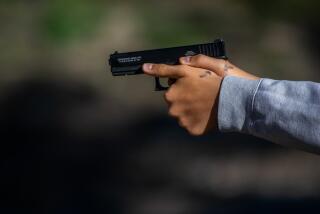Teenagers Learn Lesson About Nonviolence
- Share via
It isn’t exactly “West Side Story.” Still, in its modest way, the skit that 19-year-old Willie Truong has written for a teen holiday party in Chinatown tells its own story of urban romance, rivalry and tragedy.
In it, a young Asian American gangbanger fights another young man over a girl. A security guard intervenes; the gangbanger stabs him. In jail, the now-humbled assailant laments to his family that he has ruined his life. The family leaves, and his grandmother bids a somber farewell. “Peace out,” she says.
Laughter cascades through the room where Truong and three other young people are practicing the skit for a holiday party sponsored by the Chinatown Service Center, a social service agency in Chinatown.
The teenagers, all of whom live in the general vicinity, are participating in an anti-violence program run by the center and funded by a $7,500 grant from the Los Angeles Times Holiday Campaign, which raises money for nonprofit agencies in Los Angeles, Orange, Riverside, San Bernardino and Ventura counties.
“Man, a granny isn’t going to say ‘Peace out!’ ” said Hang Kim, a 15-year-old high school sophomore.
Truong tries to defend the line, but is met with more derision.
A lesson is learned: You can’t fight the critics. But the teens participating in the program say they also are learning -- and teaching -- valuable lessons about how to get along in a violent world without resorting to violence yourself.
“I used to do violent stuff,” said 14-year-old Brian Situ, who joined the program at the beginning of the school year. Without saying what exactly he did, he speaks casually about guns and knives. “But now,” he added, “I’ve stopped.”
The program reaches teens such as Brian through outreach programs run by interns, young people who have been involved in the program and identified as leaders.
The interns, led by coordinator Jessica Oei, teach students that there are alternatives to violence, and that violence can have disastrous consequences.
The participants are encouraged to take part in their own outreach efforts, such as the holiday party and trips to a domestic violence center, and to internalize lessons about anger management and defusing violent situations.
It doesn’t always work. But the participants -- there are about 15 at the moment, including four interns -- say the lessons help, and give them hope that they can have an impact on the larger Chinatown community, where, they say, gang and domestic violence are serious problems.
Oei, 25, said the young people are typically drawn to the program’s weekly meetings out of boredom, not idealism. Plus, she said, “They want to be where their friends are.”
But once there, they are drawn to the idea of community service and the message of nonviolence.
Charlie Chan is a 15-year-old who lives in Chinatown and goes to school in Woodland Hills. He said he has been suspended twice for fighting, but the Chinatown program has taught him to cool down.
He said he knows now “not to start stuff with other people. If they want to start something, just walk away from it or talk to them.”
Does that work? He shrugs. “Sometimes,” he said.
It’s a start.
*
HOW TO GIVE
The annual Holiday Campaign is part of the Los Angeles Times Family Fund, a fund of the McCormick Tribune Foundation, which this year will match the first $800,000 raised at 50 cents on the dollar.
Donations (checks or money orders) supporting the campaign should be sent to: L.A. Times Holiday Campaign, File 56986, Los Angeles, CA 90074-6986.
Do not send cash. Credit card donations can be made on the Web site latimes.com/holiday campaign. All donations are tax-deductible.
Contributions of $50 or more may be published in The Times unless a donor requests otherwise; acknowledgment cannot be guaranteed.
For more information, call (800) LATIMES, Ext. 75771.
More to Read
Sign up for Essential California
The most important California stories and recommendations in your inbox every morning.
You may occasionally receive promotional content from the Los Angeles Times.













